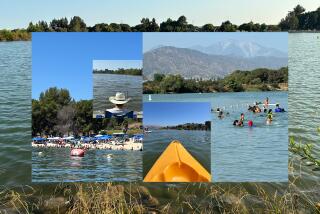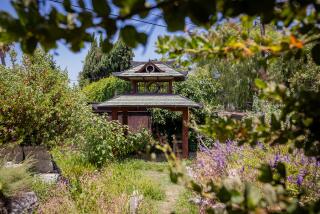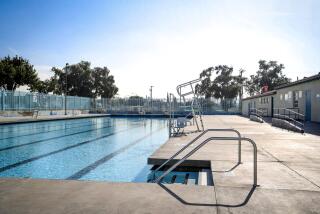Step Into Liquid
- Share via
Fly over L.A., and you see them--mile after liquid mile of dots and squares pressed like jewels into the landscape. By the latest count from the American Water Works Assn., between half a million and 700,000 pools adjoin single-family homes in Southern California. And yet as suited as they are to our hot, dry climate, they weren’t always so common here.
Through the 1930s, private pools were a privilege of the rich, who could afford poured-concrete versions of epic size. Douglas Fairbanks and Mary Pickford, for instance, had a pool with a sandy beach and specially built ponds so large that you could paddle canoes in them--if you could first manage the five-figure price tag.
Then, in 1940, landscape architect Philip Ilsley built the first so-called “people’s pool” in West L.A.--for less than $1,700. Rather than pouring--or hand-packing--concrete into steel-mesh forms, he sprayed it on, a process borrowed from the building trade. “Guniting,” as it’s known, cut the time and cost of construction, revolutionizing the pool business. And though World War II squelched all nonessential building, the business revved up once the GIs came home.
Soon companies such as Anthony, Sylvan and California Pools joined Ilsley’s Paddock Pools to meet the demand. Banks offered special financing. Many new pools went in the ground for about $2,500, which is a far cry from the $40,000 price of a modest gunite pool today, says Nord Eriksson, a second-generation landscape architect and principal of EPT Design in Pasadena.
True, nearly anything you could buy in 1950 would seem a bargain at current prices. The median L.A. County home was around $7,000, compared with about $359,000 in 2003. Still, if you do the math, you’ll find that the cost of a pool has climbed more slowly than the price of a house. Fifty years ago, you might have paid a third of your home’s value for a pool; today it’s close to a tenth.
During the ‘50s and ‘60s, thousands of simply designed pools were built, aimed at swimming rather than play. They were part of the concept of the open-plan, mid-century house, says Robert Eriksson, Nord’s father and a co-founder of EPT, who began practicing landscape architecture in 1953. In addition to cutting the price tag, “gunite freed up the form of the pool and made it easier to give it curves, which could then play off the straight lines of the contemporary house,” Eriksson says.
That classic kidney-shaped pool had a deep end for diving and a shallow end for wading. It was plastered white, which made the water appear turquoise blue, like the sky. Yards of concrete surrounded it, and the entire garden was frequently devoted to it, with plants relegated to the sidelines. Subsequent upgrades in products and technology quickly made it more efficient. Improved water filters helped screen out debris; stabilized chlorine compounds kept water purer longer than earlier chlorine additives; pool safety covers reduced accidents and, incidentally, heat loss and evaporation. In addition to pool builders--a category of professional that had scarcely existed in previous eras--another specialist emerged to help homeowners tend their new toy: the pool man, with his pole nets and plastic jugs.
Each decade brought new spins to the backyard aquatic scene. In the 1960s, volume builders began offering standardized pool models to suit customers’ tastes--those curvy kidneys, understated rectangles, rectangles with embellished corners or rounded ends. Automatic pool cleaners came on the market to help with maintenance (see sidebar on Page 64).
In the 1970s, the in-ground gunite spa arrived, and with it, the steamy hot-tub culture for which California became famous. In addition, naturalistic, rock-edged pools were popular, along with interior finishes such as dark blue or black plaster meant to suggest deep-bottomed lagoons, rustic ponds or alpine lakes. Interest in fitness mushroomed, and lap pools were shoehorned into places too narrow for family swimming.
In the ‘80s, pebble aggregates and acrylic admixtures were sometimes substituted for plaster surfaces. Soft grays, sandy browns and other subtle colors became integrated into finishes, turning water teal-blue and pale jade-green in lieu of turquoise. Then, in the early ‘90s, as more hillside lots were developed for homes, the infinity-edge pool emerged as the aquatic element-du-jour for those with views, especially ocean ones. In these features, water that appears to flow off the far edge of the pool--becoming part of that distant ocean--actually falls into a hidden catch basin on the slope below and is recirculated. The infinity edge is still popular among the affluent, according to pool builders and designers, and there are even lower-cost vinyl and fiberglass versions available.
Recent trends include spills and fountains that offer the beauty and sounds of moving water. But an even bigger look is the way pools are increasingly integrated into gardens as part of an overall scene rather than as the dominant feature. Mark Tessier, director of the landscape division of Rios Clementi Hale Studios in L.A., says: “The division between water and garden is diminishing. Paved decks are shrinking, and people are more comfortable with plants growing up close to a pool’s edge.”
Tessier, who likes to soften stone or concrete paving with the lushness of green, favors plants associated with water--rushes and cannas, for example--for poolside beds. Nord Eriksson is fond of small lawn panels around pools: “They’re wonderfully cool to the feet.”
Eriksson attributes shrinking decks partly to “societal trends away from tanning, which called for lots of sunny space for lounge chairs.” Similar trends, he says, have prompted other changes. “Pools are shallower. You don’t see deep ends and diving boards. It’s more about hanging out in the water with your family and friends.”
Safety is a continuing obsession among parents. Regulations mandating pool fences and gates have been part of L.A.’s municipal code for more than a decade. Homeowners may also choose to add automatic pool covers and alarm doors.
“When I was growing up, fenced pools were rare,” Nord Eriksson recalls. “Now some of my clients won’t build a pool until their kids are grown.” In some cases, they even fill in existing pools, which can cost nearly half as much as new construction.
Conservation concerns also can prompt owners to fill in pools. The Metropolitan Water District of Southern California reports that 19,659 gallons of water evaporate from a single swimming pool annually. But that problem can be mitigated by a cover. Last summer, David Hill, manager of water resources for the Inland Empire Utilities Agency, oversaw a rebate program that rewarded homeowners who purchased approved pool covers. The results? When covers were used at least five days a week, owners saved between 8,000 and 10,000 gallons of water per year. Hill says a solar cover can extend the swimming season in an otherwise unheated pool by two months. A simple vinyl solar cover runs a mere $100, while an automatic, electrically operated safety cover is $7,000 to $10,000.
Frequent swimming raises another issue: exposure to chlorine. “Some people are very sensitive to it,” says Ken Thomason, a 30-year industry veteran who owns Thomason Pool Construction in Brentwood. The most common alternatives are either a saltwater or an ozone-generating purification system. The first, which costs about $2,000, converts salt to chlorine in a way that’s gentler on the body. The second, close to three times the cost, draws oxygen under a vacuum and through a high-voltage electrical chamber, changing it into ozone, which then acts as a water sanitizer. Neither is without flaws. For one thing, not all service personnel know how to maintain these systems. Ozone alone is sometimes inadequate without backup doses of bromine, a somewhat milder and more expensive purifier than chlorine. And salt can be corrosive to surrounding paving.
However, Bruce Dunn, co-owner of Escondido-based Mission Pools, which builds 800 Southland pools annually, has seen an overall revolution since he began 30 years ago. “Pools are a lot more user-friendly. You can pre-program your temperatures, your spa and your lights from the house. Filtration, water turnover and automatic cleaners have gotten better. The mechanical equipment has all been upgraded; it’s dependable; it does what it says it’ll do.”
But increased sophistication has also led to pools that can be harder for owners to maintain. “It’s like a car. People used to fix their own,” says Bob Dumas, technical editor for Pool & Spa News. In the same way, he warns, “The do-it-yourself approach is initially cheaper, but if you don’t know what you’re doing, it’s going to cost more.”
Proper pool care requires an understanding of water chemistry, he says. For chlorine to be effective and the pool to stay clear and algae-free, water must be correctly balanced, which means the right pH, alkalinity and calcium hardness. And even an automatic pool cleaner won’t vacuum every inch of pool wall or steps or remove all garden debris or notice when complicated equipment goes awry. “When you build a pool, you make a huge investment,” says Dumas. “It makes sense to spend the extra money on a pool service to protect it.”
To keep your pool inviting, you might drop between $300 and $1,300 for an automatic pool cleaner (not including installation). The monthly cost of electricity to operate a pool, along with the cost of cleaning products and chemicals, can vary dramatically depending on climate conditions, environmental issues and source water. If you hire a service technician for cleaning and maintenance, expect to pay between $50 and $150 a month.
Sometimes the upkeep can devalue a pool as a real-estate commodity. “In some areas,” says Jerry Jaffe, a real estate agent for RE/MAX All Cities Realty, “a pool could decrease a home’s value. On the Westside, where the climate is cooler, people aren’t as willing to accept the maintenance and would rather use the land for a yard. In parts of the Valley, where it’s hotter, pools add value. But they also do that just about anywhere if they’re beautiful and architectural.”
For Michael Ferguson, an architect and principal of Space International in L.A., not having a pool was unthinkable as he planned his recently completed Mount Washington house. “I used to be a swimmer,” he reflects, “and I want to be again. It was really important to me to have this amenity close by.” Wife Kathleen Ferguson, a landscape designer, believes the pool’s aesthetics are crucial. “She sees it as a glorified water feature,” Michael says. Luckily they were able to tuck the pool in as part of a necessary retaining wall for their hillside lot. The added cost? A cool $20,000.
Once they move into the house next month, they plan to swim laps--albeit short ones--along the pool’s 38-foot length. By night they envision lounging on an adjacent terrace, enjoying the blue glow of the pool’s lit depths. “It’s an extra luxury for us,” Michael admits, “especially on a very small lot.” But worth it. “I’ve never had a pool before,” he says. “I’m from North Carolina.”
Choosing a Pool Cleaner
When you buy an automatic pool cleaner, you’re embarking on a long-term relationship. So do you choose the steady, quiet type, the blustery powerhouse or the independent can-doer? Whatever you pick, you’ll see a lot of it--several hours a day--so looks and size do matter. Don’t expect your robotic partner to do it all: Every machine misses spots, which must be cleaned by hand. Look online for better-than-retail prices, but know that installation in older pools, which may require additional plumbing and wiring, may boost the cost by several hundred dollars.
* Small and quiet: A suction-side cleaner plugs into your pool’s skimmer or dedicated cleaning line and sends debris to the pool’s filter. Two examples are Pentair’s aptly named, random-pattern Kreepy Krauly ($400 to $800) and the Hayward Navigator, which adds programmed steering (about $300).
* Primed and pumped: A pressure-side cleaner hooks up to a pool’s dedicated return line (which returns water to the pool from the filter) and uses a booster pump to create a high-pressure water stream. Among these, the Polaris Vac-Sweep 380 has a debris-churning sweep tail and a filter bag to capture dreck ($549, plus $250 for the booster pump).
* Goes both ways: Jandy’s Ray-Vac uses suction and pressure to clear the water and vacuum the pool, pushing some debris to the main drain with a sweeping hose and drawing some into its ray-shaped head (about $800).
* Smooth operator: Robotic cleaners zoom around pool walls, floors and waterline, climbing, cleaning and trapping dirt. The Dolphin Diagnostic 2001, which plugs into any electrical outlet, does the job with two low-voltage motors, one to drive it and one to pump water through its onboard filtration system (about $1,240).
More to Read
Sign up for The Wild
We’ll help you find the best places to hike, bike and run, as well as the perfect silent spots for meditation and yoga.
You may occasionally receive promotional content from the Los Angeles Times.






